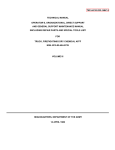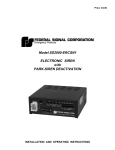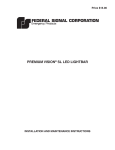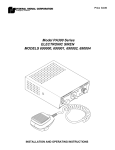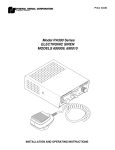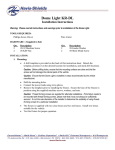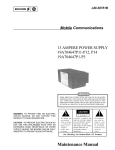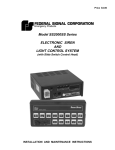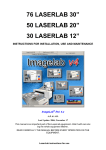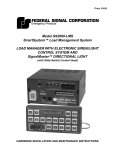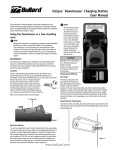Download Installation Instructions for Model PA500F
Transcript
PRICE $4.00 MODEL PA500F ELECTRONIC SIREN SERIES B INSTALLATION AND SERVICE INSTRUCTIONS SECTION I GENERAL DESCRIPTION Figure 1-1. Model PA500F Electronic Siren. The Model PA500F is designed to drive one or two 58 or 100 watt speakers. Using two 100-watt speakers will provide maximum traffic clearing power. The Federal Model PA500F is a precision built, efficient and economical full-featured electronic siren of advanced design. It provides wail, yelp and hi-lo siren tones, as well as the Tap II feature, public address (PA), radio rebroadcast and an air horn sound. The Tap II feature allows the driver to change the siren sound from wail to yelp (or vice-versa) via the vehicle’s horn ring or by activating the MANUAL SIREN switch on the Control Head. The siren may be installed in negative ground vehicles with 12-volt electrical systems. It is protected against failure modes (including reversed polarity) by a fuse that is replaceable without tools. No components protrude from the bottom of the siren to interfere with mounting arrangements. Other special features of the Model PA500F include: The siren is made up of an Amplifier and a Control Head. The Amplifier is suitable for mounting in a dry, adequately ventilated location, while the Control Head is designed for flush mounting in the vehicle interior. A noise-cancelling microphone is wired-in to prevent loss or theft. It provides high quality voice reproduction without feedback (squeal). The microphone push-to-talk switch overrides any siren signal for instant PA use. PA and radio volume are preset at the factory for maximum gain. Radio interconnect wires are supplied as part of the control cable. Additional cabling is not required. 1-1 • High degree of reliability is achieved through the use of integrated circuits and silicon output transistors. • Control panel is illuminated with non-glare lighting. • Newly designed printed circuit board provides improved performance and durability under a wide range of environmental conditions. • Use of screw-terminated terminal block for easy installation of control cable at Control Head. SECTION II SPECIFICATIONS Input Voltage . . . . . . . . . 11 Vdc to 16 Vdc Polarity . . . . . . . . Negative ground electrical systems only . . . . . . . . 520mA (incl. panel lights) Operating Current (Control Head & Ampl.) . 13.3A ±1A (at 13.6V with 5.5-ohm load) Frequency Range . . . . . . . . 500 to 1500 Hz (nominal) Cycle Rate . . . . . . . . Wail- 12 cycles/min. Yelp- 180 cycles/min. Hi-Lo- 60 cycles/min. Voltage Output (approx.) . . . . . . 62V peak-to-peak Audio Frequency Range . . . . . . 300 to 10KHz Harmonic Audio Distortion. (300-3000Hz) . . . . . 10% max. all power levels from 1/2 to 50 watts (frequency response ±3dB) Operating Temperature Range . . . . . -30°C to +65°C Dimensions (HWD) Control Head. . Amplifier Module . . . . . . . . . . . . 3" x 6" x 2" 3-1/4" x 4-1/2" x 7-3/8" Net Weight . . . . . . 4-1/2 pounds Shipping Weight (approx.) . . . . . . 6 pounds . . Standby Current . . . . . 2-1 SECTION III INSTALLATION SAFETY MESSAGE TO INSTALLERS OF ELECTRONIC SIRENS WARNING The lives of people depend on your safe installation and servicing of Federal products. It is important to read and follow all instructions shipped with the products. In addition, listed below are some other important safety instructions and precautions you should follow: • Sound output will be severely reduced if any objects are in front of the speaker. If maximum sound output is required for your application, you should ensure that the front of the speaker is clear of any obstructions. • Install the speaker(s) in a location which provides maximum signaling effectiveness and minimizes the sound reaching the vehicle’s occupants. • Installation of two speakers requires wiring speakers in phase. • DO NOT install equipment or route wiring or cord in the deployment path of an air bag. • Locate the control head so the vehicle, controls, and microphone can be operated safely. • When drilling into a vehicle structure, be sure that both sides of the surface are clear of anything that could be damaged. • If wiring is shorted to vehicle frame, high current conductors can cause hazardous sparks resulting in electrical fires or flying molten metal. Before Installation Qualifications • To properly install an electronic siren: you must have a good understanding of automotive electrical procedures and systems, along with proficiency in the installation and service of safety warning equipment. Sound Hazards • • Your hearing and the hearing of others, in or close to your emergency vehicle, could be damaged by loud sounds. This can occur from short exposures to very loud sounds, or from longer exposures to moderately loud sounds. For hearing conservation guidance, refer to federal, state, or local recommendations. OSHA Standard 1910.95 offers guidance on “Permissible Noise Exposure.” All effective sirens and horns produce loud sounds which may, in certain situations, cause permanent hearing loss. You should minimize your exposure times and wear suitable hearing protection. After Installation During Installation • • • DO NOT connect this system to the vehicle battery until ALL other electrical connections are made, mounting of all components is complete, and you have verified that no shorts exist. Be sure the siren amplifier and speaker(s) in your installation have compatible wattage ratings. In order for the electronic siren to function properly, the ground connection must be made to a solid chassis component and not to an insulated point. • After installation, test the electronic siren, speaker system, and light system to ensure that it is operating properly. • Test all vehicle functions, including horn operation and vehicle light systems, to ensure proper operation. • After testing is complete, provide a copy of these instructions to the instructional staff and all operating personnel. • File these instructions in a safe place and refer to them when maintaining and/or reinstalling the product. Failure to follow all safety precautions and instructions may result in property damage, serious injury, or death to you or others. 3-1 3-1. UNPACKING. 3-3. CONTROL HEAD INSTALLATION. After unpacking the Model PA500 F, examine it for damage that may have occurred in transit. If the equipment has been damaged, file a claim immediately with the carrier stating the extent of the damage. Carefully check all envelopes, shipping labels and tags before removing or destroying them. WARNING When installing equipment inside air bag equipped vehicles, the installer MUST ensure that the equipment is installed ONLY in areas recommended by the vehicle manufacturer. Failure to observe this warning will reduce the effectiveness of the air bag, damage the air bag, or potentially damage or dislodge the equipment, causing serious injury or death to you or others. 3-2. AMPLIFIER INSTALLATION. A. Secure both mounting brackets to the chassis with #10 thread-forming hex. head screws (2 for each bracket), as shown in figure 3-1. CAUTION The Control Head is designed to be flush mounted in any relatively flat surface. To install, proceed as follows: The Amplifier is NOT waterproof. It must be mounted in a location which is sheltered from falling rain, snow, standing water, etc. Also, it must be installed in an adequately ventilated area. Never install near heater ducts. A. Select a location for the Control Head on the mounting surface that does not impair the drivers’ ability to safely drive the vehicle as he operates the siren. The selected location should afford good visibility and free accessibility to the Control Head controls. Do not mount the Amplifier under the vehicle’s hood. B. Select a suitable mounting location for the Amplifier. Some possible mounting locations are: in the equipment cabinet, under the front seat, or in the trunk (under the rear deck, near the rear seat speakers, if vehicle is so equipped). Keep in mind that the control cable is 10 feet long and the power cable is 8 feet long. B. Place the mounting template, supplied in the accessory kit, over the selected mounting location. Scribe a mark for each of the four mounting holes. Also, scribe a cut mark along the heavy dark line on the template. C. Using the chassis mounting brackets as templates, scribe four drill position marks at the mounting location. CAUTION Take care not to damage wires or linkages located behind the dashboard, while performing steps C. and D. CAUTION Before drilling holes in ANY part of a vehicle, be sure that both sides of the mounting surface are clear of parts that could be damaged; such as brake lines, fuel lines, electrical wiring, or other vital parts. C. Drill four 0.120 diameter (#31 drill) mounting holes at the marks scribed in step B. D. The mounting hardware supplied in the siren accessory kit provides the siren user with a choice of mounting hardware; thread-forming screws with lockwashers or 1/4-20 cap screws with lockwashers and hex nuts. Consequently, the holes drilled in the mounting surface must be appropriate for the mounting screws selected. If the threadforming screws are to be used, drill 3/16" holes at the drill position marks. Drill 9/32" holes at the position marks if the 1/4-20 cap screws, lockwashers and nuts will be used. Secure the Amplifier to the mounting surface, using the mounting hardware, including lockwashers. Figure 3-1. Mounting Bracket Installation. 3-2 D. Using a keyhole saw or sabre saw, saw into the mounting surface at the cutmark scribed in step B. 3. If routing the cable requires drilling a hole in sheet metal or other material, drill a 5/8" hole in the material. Install 5/8" grommet (not supplied) or similar protective device in the hole, to protect the cable from damage which sharp edges could cause. NOTE Before completing the Control Head installation, perform the procedures in paragraph 3-4, Electrical Installation. 4. Connect the wires from the 9-conductor cable and 3-conductor audio cable to the terminal block (TB1) installed on the Control Head PC board. The PC board is silk-screened to identify both cables (audio and control), and wire colors are also identified for ease of installation. E. With all wiring connections complete, place the Control Head in position and secure to mounting surface with four (4) #6B Phillips head threadforming screws (supplied). 5. The clear zip cord, which is also part of the control cable, can be used to allow incoming radio messages to be rebroadcast over the outside speaker. To make this feature available, merely connect the zip cord across the two-way radio’s speaker. NOTE If it is desired or necessary, three adhesive backed gasket strips are included with the accessory kit to prevent light from bleeding through the mounting between the Control Head and mounting surface. B. Speaker. The unit is designed to operate with either one or two low power (58-watt) or high power (100watt) 11-ohm impedance speakers. 3-4. ELECTRICAL INSTALLATION. WARNING A speaker is not included as part of the electronic siren. FEDERAL speakers are weatherproof and may be installed in any convenient location; on the roof, fender, behind the grille, etc. Any special mounting instructions applicable to the type of speaker you have selected will be found in the speaker carton. Failure to observe this WARNING may result in fire, burns or blindness. If shorted to vehicle frame, high current conductors can cause hazardous sparks resulting in electrical fires or molten metal. DO NOT connect this system to vehicle battery until ALL other electrical connections are made and mounting of all components is complete. Connect the speaker(s) to the siren using user-supplied two conductor cable having 18AWG, or larger, conductors. Connections from the speaker should be made at the terminal strip , above the control cable plug, as shown in figure 3-2. Verify that no short circuits exist, before connecting to the Positive (+) battery terminal. A. Control Cable. When using a low power (58-watt) speaker, one of the speaker leads should be connected to the COM terminal and the other lead should be connected to the LO PWR terminal. High power (100-watt) speakers should be connected to the COM and HI PWR terminals. When two speakers are used, it is necessary to connect the speakers in parallel and in phase for optimum performance. On Federal speakers, this can be accomplished by connecting the two-speaker leads marked “1” to the COM terminal on the siren and the two leads marked “2” to the HI PWR or LOW PWR terminal (as applicable) as shown in figure 3-2. The control cable is designed to be installed between the Amplifier and the Control Head. It consists of a 9-conductor cable, a 3-conductor audio cable and clear zip cord. To install the control cable, proceed as follows: 1. Install the control cable connector to the mating connector on the Amplifier. 2. Route the control cable toward the Control Head. C. WARNING Before drilling holes in ANY part of a vehicle, be sure that both sides of the surface being drilled are clear of parts that could be damaged; such as brake lines, fuel lines, electrical wiring, linkages or other vital parts. Power Cable. The power cable assembly, located in the accessory kit, is a 4-wire cable terminating in an orange edge connector. This connector should be installed on the mating 4-pin connector (J2) located on the Control Head PC board, and should be ori 3-3 ented so that the wires protrude toward the middle of the board. The following paragraphs describe the installation of the leads at the other end of the power cable. 1. c. Splice the white/yellow wire in the power cable to the horn side of the cut wire. Insulate the splice with a wire nut (supplied). d. Obtain an SPST relay of sufficient contact current capacity to activate the vehicle horn. Refer to figure 3-3 while performing the following steps. Horn Ring (figure 3-3). If the horn ring will not be used to control siren operation, fold back and insulate the YEL and WHT/YEL wires in the power cable and disregard the procedure in this paragraph. However, in order to utilize the Tap II and Press-and-Hold features of the siren, the following procedure must be performed. e. Mount the relay in a suitable location. f. Connect the horn side of the wire cut in step a. to the relay contact terminal. g. Determine the “sense” of the vehicle’s horn ring activation circuit, i.e. does the horn circuit require a switched positive voltage or switched ground for activation. a. Locate the wire that connects the vehicle horn ring switch to the horn or horn relay. Cut this wire. b. Splice the yellow wire in the power cable to the horn ring side of the wire that was cut in step a. Insulate the splice with a wire nut (supplied). h. Connect the relay wiper terminal to the positive or negative potential determined in step g. i. Connect the white/yellow wire in the power cable to one end of the relay coil. CAUTION j. Connect the other end of the relay coil to the opposite potential of that connected to the wiper in step h. The horn ring transfer circuit of the siren is capable of switching a maximum of 2-amperes. Some vehicles do not have a horn relay and, consequently, will draw more than 2-amperes when the vehicle horn is activated. Consult your vehicle service manual or a qualified mechanic to determine the current required to activate the horn. If it is less than 2-amperes, perform the procedure in step c. If it is greater than 2-amperes, perform steps d. through j. 2. Ignition. a. Connect the wire marked “IGNITION” to the vehicle ignition or accessory circuit. This connection will supply power to the Control Head panel lights and two-way radio control head whenever the vehicle ignition key switch is in the “on” position. Figure 3-2. Speaker Connections. Figure 3-3. Horn Ring Connections. 3-4 If necessary, drill a 5/8" hole in the vehicle firewall. Install a user-supplied 5/8" grommet, or similar device or material, to protect the wiring and cabling against damage from rough edges. b. Connect the wire marked “GROUND” directly to the vehicle frame. The Control Head can now be secured to the vehicle dashboard. D. 3. Route the fused power lead (spade tongue lug end) from an area near the battery to the Amplifier. (Do not connect to battery at this time.) If necessary, pass the lead through the 5/8" hole that was drilled in step 2. Amplifier Power Connections. Locate the fused power lead and ground lead in the accessory kit. Both leads are #14AWG. 1. Connect the spade tongue lug end of the ground lead to the NEG terminal of the Amplifier. Connect the other end of this lead to the vehicle chassis as close as practical to the Amplifier. 4. Connect the spade tongue lug on the fused power lead to the POS terminal on the Amplifier. 5. Connect the ring terminal on the remaining end of the power lead directly to the positive terminal of the battery. WARNING Before drilling holes in ANY part of a vehicle, be sure that both sides of the surface being drilled are clear of parts that could be damaged; such as brake lines, fuel lines, electrical wiring, linkages or other vital parts. 3-5. TESTING AFTER INSTALLATION. After installation, test the electronic siren, including horn operation, to ensure that it is operating properly. 2. If the Amplifier is installed in the vehicle passenger compartment, it will be necessary to drill a 5/8" hole in the vehicle firewall for the fused power lead. After testing is complete, provide a copy of this manual to all operating personnel. 3-5 SECTION IV OPERATION SAFETY MESSAGE TO OPERATORS OF FEDERAL SIGNAL ELECTRONIC SIRENS AND LIGHT/SOUND SYSTEMS WARNING Signaling Limitations The lives of people depend on your safe operation of Federal products. It is important to read and follow all instructions shipped with the products. In addition, listed below are some other important safety instructions and precautions you should follow: • Be aware that the use of your visual and audible signaling devices does not give you the right to force your way through traffic. Your emergency lights, siren, and actions are REQUESTING the right-of-way. • Although your warning system is operating properly, it may not alert everyone. People may not hear, see, or heed your warning signal. You must recognize this fact and continue driving cautiously. • Situations may occur which obstruct your warning signal when natural or man-made objects are between your vehicle and others, such as when you raise your hood or trunk lid. If these situations occur, be especially careful. Qualifications • To properly use an electronic siren and speaker(s): you must have a good understanding of general vehicle operation, a high proficiency in the use of safety warning equipment, and thorough knowledge of state and federal UNIFORM TRAFFIC CODES. Sound Hazards • • Your hearing and the hearing of others, in or close to your emergency vehicle, could be damaged by loud sounds. This can occur from short exposures to very loud sounds, or from longer exposures to moderately loud sounds. For hearing conservation guidance, refer to federal, state, or local recommendations. OSHA Standard 1910.95 offers guidance on “Permissible Noise Exposure.” Driving Limitations All effective sirens and horns produce loud sounds which may, in certain situations, cause permanent hearing loss. You should minimize your exposure times and wear suitable hearing protection. • At the start of your shift, you should ensure that the light/sound system is securely attached to the vehicle and operating properly. • If the unique combination of emergency vehicle equipment installed in your vehicle has resulted in the siren controls being installed in a position that does not allow you to operate them by touch only, OPERATE CONTROLS ONLY WHILE YOUR VEHICLE IS STOPPED. • If driving conditions require your full attention, you should avoid operating the siren controls while the vehicle is in motion. Sound Limitations • • Maximum sound output will be severely reduced if any objects are in front of the speaker. If your installation has obstructions in front of the speaker, drive even more cautiously. Continuing Education • Frequently inspect the speaker to ensure that it is clear of any obstruction, such as mud or snow, which will reduce maximum sound output. File these instructions in a safe place and refer to them periodically. Give a copy of these instructions to new recruits and trainees. Failure to follow these safety precautions may result in property damage, serious injury, or death to you, to passengers, or to others. 4-1 4-3. ON/OFF SWITCH. 4-1. GENERAL. The ON/OFF switch controls all power to the Model PA500F. Depressing the switch to ON, illuminates the Control Head and activates a relay within the Amplifier which allows power to be applied to the Amplifier electronic circuitry. All controls utilized during normal operation of the Model PA500F are located on the Control Head (see figure 4-1). 4-2. SELECTOR SWITCH. 4-4. AIR HORN/MANUAL SIREN SWITCH. The Selector switch is a five-position rotary switch used to select the mode of operation. The following are positions on the Selector switch. A. The AIR HORN/MANUAL SIREN switch activates the electronic air horn sound (up) in any selected position, except RADIO and the peak-andhold sound in the STBY position RADIO. 4-5. TAP II FUNCTIONS. In this position, incoming radio messages are amplified by the siren and rebroadcast over the outside speaker. B. Tap II allows the driver to change the audible siren sound via the vehicle’s horn ring. This feature is especially effective for clearing traffic. The chart below demonstrates how the horn ring can be used to change the siren sound. STBY. In this position, it is possible to operate the siren by activating the AIR HORN/MANUAL SIREN switch. The siren can also be activated by means of an auxiliary switch, such as the horn ring button (refer to paragraph 4-6). C. TAP II FUNCTIONS WAIL. In this position, the siren produces a continuous “wailing” sound , up and down in frequency. D. First Horn Ring Tap Produces Second Horn Ring Tap Produces Wail Yelp Yelp Wail Wail Yelp 4-6. PRESS-AND-HOLD FUNCTION. Additional alternate sounds can be activated when the Selector switch is set to STBY or HI-LO. While depressing and holding the horn ring and the Selector switch set to STBY, peak-and-hold siren will sound. In the HI-LO position the air horn will sound. Releasing the horn ring will cause the siren to revert back to the original function. YELP. In this position, a continuous rapid “warbled” tone is generated. E. Selector Switch Position HI-LO. In this position, a two-tone sound will be heard. This distinctive tone may be reserved for any special indication situation. The TAP II functions can also be activated by depressing the MANUAL SIREN switch, as shown below: Selector WAIL YELP HI-LO 1st Tap (MANUAL) Yelp Wail Air Horn 2nd Tap (MANUAL) Wail Yelp Hi-Lo NOTE Peak-and-hold siren and air horn are the “Press and Hold” features. Figure 4-1. Control Head Front View. 4-2 SECTION V SERVICE AND MAINTENANCE Communications and shipments should be addressed to: SAFETY MESSAGE TO PERSONNEL SERVICING FEDERAL SIGNAL ELECTRONIC SIRENS Service Department Federal Signal Corporation 2645 Federal Signal Drive University Park, IL 60466 The lives of people depend on your safe servicing of Federal products. It is important to follow all instructions shipped with the products. In addition, listed below are some other safety instructions and precautions you should follow: • 1-800-433-9132 (In Illinois) 1-708-534-3400 Read and understand all instructions in this manual before servicing electronic siren. • To properly service an electronic siren, you must have a good understanding of automotive electrical systems and emergency signalling procedures. • All effective sirens and horns produce loud sounds which may cause, in certain situations, permanent hearing loss. You should take appropriate safety precautions such as wearing hearing protection. If any unit is returned for adjustment or repair, it can be accepted only if we are notified by letter or phone in advance of its arrival. Such notice should clearly indicate the service requested and give all pertinent information regarding the nature of malfunction and, if possible, its cause. 5-2. SIREN. • DO NOT connect this system to the positive terminal of the battery until servicing is complete, and you have verified that there are no short circuits to ground. • In order for the electronic siren to function properly, the ground connection must be made to a solid chassis component and not to an insulated point. A. General. Any competent radio repairman or electronic technician should have little difficulty in tracing and correcting a malfunction, should any occur. For emergency replacement of any of the small components, care must be used when soldering. Heat easily impairs transistors, capacitors and circuit boards. It is therefore advisable to use longnose pliers or a similar heat sink on the lead being soldered. If IC13 or C21 are replaced, it may be necessary to adjust R57. With the Selector Switch set to STBY, hold the AIR HORN/MANUAL SIREN switch in the MANUAL SIREN position and adjust R57 for 1400Hz at the siren output. Failure to follow all safety precautions and instructions may result in property damage, serious injury, or death to you or others. B. Removal for Servicing. 5-1. GENERAL. To remove the electronic assembly, located inside the Amplifier chassis, for servicing; proceed as follows (see figure 5-1): Most of the component electronic parts used in the Model PA500F are standard items that can be obtained from any radio or electronics supply shop. In order to reduce equipment down-time, Federal recommends that the entire printed circuit board (Part No.2001072) be replaced. The printed circuit boards are relatively inexpensive allowing you to keep an adequate supply in your repair shop. 1. Remove the four #10 thread-forming hex head screws which secure the Amplifier chassis to the mounting brackets (two screws on each bracket). Lift the Amplifier away from the mounting brackets. The factory can and will service your equipment or assist you with technical problems, should any arise, that cannot be handled satisfactorily and promptly locally. 2. Remove the four hex head screws on the amplifier’s bottom which secure the cover to the Amplifier chassis. 5-1 D. Replacement of Output Transistors. Failure of one or both of the output transistors (Q201, Q202) is usually the result of a defective speaker (short circuited voice coil). Rebroadcast of the unsquelched radio or music for long periods will also have a detrimental effect on the output transistors, and is therefore not recommended. Federal recommends that both output transistors be replaced should only one device prove to be defective. This practice will insure long periods of service between failures. When installing new output transistors, insure that the Sil-Pad insulators are installed between the heatsink and transistors. CAUTION Make certain that the speaker is not defective prior to installing the repaired PA500F. E. Testing. After servicing is complete, perform a test of all functions to ensure siren is operating properly. Figure 5-1. Chassis Removal. 3. Remove the cover by sliding it away from the connector end of the chassis. C. Removal of Circuit Board. The PC Board is secured to the chassis by four Phillips head screws. Unplug the four wafer connectors before removing the screws. Figure 5-2. Internal View. 5-2 5-3. REPLACEMENT PARTS LIST. Reference Designation Q201, Q202 F1 DS1, 2, 3 Description Part Number Transistor, 2N5885, NPN, Power Fuse, 20A, 3AG Lamp, Panel Insulator (Q201, Q202) Main Circuit Board (with parts installed) Output Circuit Board (with parts installed) Control Head Circuit Board (with parts installed) Chassis Cover Amplifier Assembly Control Assembly Accessory Kit Microphone Output Transformer 5-3 125B432 148A127 149A117 235A123A-01 2001072A 200C907 200C908B 85361080A 85361081A 8536C1025B 85361030A 85361027A 258B577A-02 120C167A Figure 5-3. Model PA500F Schematic Diagram. 255A207 I REV. I 1295 Printed in U.S.A.















